Golf Clubs
Golf Clubs
Golf Clubs have come a long way since the game first began. And although the Origins of Golf will remain a hotly debated topic as to where and when the game truly began, the fact that advances in technology have improved the play of countless millions can never be questioned.
Much like the Golf Ball grew through the years from its infancy as a rock knocked around with a bent stick, through its adolescence as a leather pouch stuffed with feathers, up through its adult years as the modern, multi-layered, dimpled sphere we play today, the golf club has seen equal improvements through the years of its maturing growth.
Technology continues to fuel the advancements in golf club and golf ball design as manufactures spend millions on the Research & Development of composite elements and materials combined with finite tweaks in design to optimize performance tailored to the unique swing characteristics of everyone who knocks that dimpled sphere across the manicured fields of a golf course.
It may not be actual Rocket Science, but the R & D that goes into the Design & Manufacture of today's golf clubs is about as close as you can get to Rocket Science since the clubs in even the amateur's bag these days can launch a golf ball as if it had rocket boosters in those dimples.
Making The Right Choices
If you're just getting started picking up this exhilarating (and sometimes equally frustrating) game, then The-Golf-Experience.com suggests you don't get too carried away with the technology of your golf balls and golf clubs. Just pick a few lower-end distance balls out of the bin and take a beginner set of high-handicapper clubs off the rack. They will serve your game just fine and leave a few pennies in your piggy bank to spend on the lessons you'll want to begin taking your game to the next level.
But once you get to the point where you can string a few good shots together and maybe even finish a round on some courses without losing a ball, then it's time to consider how today's technology can help you to maximize your unique swing to better control your ball and even shape your shots around the course.
When you get to that point we suggest you spend your next golf investment on a Professional Club Fitting before simply stuffing your bag with the hottest new clubs to hit the market. Having the right equipment in your bag to optimize your unique swing characteristics and style of play is far more rewarding than bragging about having the coolest new products.
The-Golf-Experience.com would like to first entertain you with a simple timeline of a Brief History of the Golf Club.
Below that, we provide the detailed information you'll need to better prepare you for understanding the terms and phrases your Club Fitter will discuss with you while discovering the best combination of technology and design to bring out the Inner Master's Champion in your hidden talents.
A Brief History of The Golf Club
|
960-1279: |
Royals from China's Song Dynasty play chuiwan, hitting balls into holes with a set of 10 bejeweled clubs. |
|
1400's: |
Despite earlier evidence of proto-golf in the Netherlands, Scotland gets credit for inventing the game. |
|
1800's: |
Par for the course, golf makes its way to the United States. Players use 20 to 30 wooden clubs of various functions to hit featheries, hard leather balls stuffed with feathers. |
|
1865: |
America's hickory trees get the shaft when Robert Forgan exports them to Scotland to make golf clubs. Harder persimmon wood is used for the club heads until drop forging allows for mass-produced iron heads in the late 1800s. |
|
1931: |
Billy Burke becomes the first golfer to win the U.S. Open using steel-shafted clubs painted to look like wood. But there's no faking Burke's unique grip—he only had three fingers on his left hand. |
|
1932: |
Pro golfer Gene Sarazen thinks outside the sandbox to develop the modern sand wedge, and uses it in his British Open victory. |
|
1939: |
Golf's rule-making authority decrees the use of no more than 14 clubs in a round but puts no limits on dorky apparel. |
|
1959: |
Engineer Karsten Solheim invents a putter with more weight at the heel and toe of the blade and a thinner, lighter sweet spot. The novel design makes it easier for golfers to hit the ball straight. He quits his day job, creates the golf-equipment brand Ping, and makes a fortune. |
|
1971: |
Alan Shepard takes one small swing for a man, one giant drive for mankind when he hits two golf balls on the moon at the end of the Apollo 14 mission. The second travels over a mile. |
|
1973: |
Lightweight graphite-shaft clubs become popular among women and senior golfers. The rest of the world—ahem, PGA Tour players—catches on by the mid-1990s. |
|
1980: |
In Caddyshack, Rodney Dangerfield's character stocks his bag with a driver that dispenses beer. |
|
1991: |
Callaway rocks the golf world when it introduces the Big Bertha stainless-steel-headed driver. Persimmon-headed clubs quickly become garage-cluttering relics. |
|
2013: |
TaylorMade's R1 driver adjusts to 12 different lofts and seven different face angles, adapting the club to playing conditions. Isn't that cheating? |
Golf Club Design Details
As per the rules set forth by the USGA and The Royal and Ancient Golf Club of Scotland golfers can carry up to fourteen (14) clubs in any combination of the following choices:
- Drivers & Fairway Clubs (often called "woods" - even though most are made of some other material these days)
- Hybrid Clubs (which for many golfers playing today have replaced the longer irons in the bag)
- Irons and Wedges
- Putters
And the Primary Components of those fourteen Golf Clubs in your bag are:
and you have many choices when it comes to putting them together in any combination that best suits your swing and your style of play.
The Golf Club Shaft
Think of the Golf Club Shaft as the engine of your golf club. The components of the motor that drives your Club Head at the ball consist of; its Shaft Flex, its Torque & Kick-Point, its Alignment, and its Weight & Length. These components all impact the performance of the club and how it enhances or hinders the abilities of your unique swing.
Golf Club Shaft Flex
- Shaft Flex is the relative stiffness of the shaft or flexibility relative to a specific industry standard and it may very well be the single greatest contributing variable in determining the success you will achieve with almost every club in your bag.
- Flex also refers to the rating of a golf club shaft's degree of bend during the Golf Swing.
|
The seven basic flex types listed to the right are the generally accepted criteria and definitions for determining the classification of a Golf Club's Shaft Flexibility. Golf Club Manufacturers rely on this consensus of opinion to decide upon the target demographic for a club shaft's flexibility. But the truth remains that choosing the right Shaft Flex for your game should be based on your Swing Speed and other factors that make up your unique swing and not your gender, age, or even your skill level. 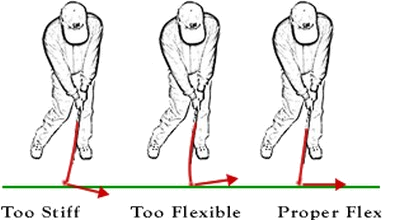 Golf Club Flexibility Golf Club Flexibility |
|
The Flex of every shaft in your bag is a vital factor in determining how well that club will perform specific to your unique swing characteristics. The Flexibility of the shaft in relation your swing will affect the flight path your ball will follow and the distance it will travel.
The basic rule to follow is that a player with a slower swing speed will need a shaft with greater flex to achieve a whip effect at impact where the club head will travel faster than the speed at which the golfer can swing the club, And a player with a very fast swing speed will require a shaft with less flex so the club head will not lag behind the hands coming through the hitting zone.
A shaft with less flexibility offers the golfer greater control of the ball and is thus preferred by better skill players who possess the ability to shape their shots around the course.
There are currently two accepted and practiced methods for determining a Golf Club Shaft's flexibility.
- The more traditional Shaft Deflection Board measures the bending characteristics of a fixed shaft when weight is applied.
- The Frequency Analyzer is an alternate way of specifying stiffness and indicates the speed with which a club will vibrate with that individual shaft.
|
|
The accuracy of Frequency Matching makes it possible to have a complete set of golf clubs dialed in to the exact desired stiffness characteristics specific to the needs of each golfer's personal swing style and club head speed. |
|
Golf Club Torque & Kick Point
Torque:
|
Torque is defined as the twisting movement of the shaft during the golf swing and is measured in degrees that illustrate the amount a club shaft is expected to twist during the golf swing. A shaft with a higher torque rating will twist more and have a softer feel and will deliver a higher ball flight trajectory at impact. A shaft with a lower torque rating will twist less and feel more stiff through the golf swing and deliver a lower ball flight trajectory at impact. Torque is also the variable that determines the shaft's resistance or tendency to twist during the downswing. Less torque means less twisting which provides for greater club control and offers more skilled golfers better control and the ablity to shape their shots around the course. |
Kick-point:
|
Kick-point (sometimes referred to as Flex-point) is that point on the golf shaft where the most focused bending takes place and most affects the trajectory of the shot.
|
The remaining factors needed to determine the proper shaft flexibility for any golfer's unique swing are; tempo, timing, degrees of swing-aggressiveness on the transition between the backswing and downswing, and the release point at impact.
Profiling the Golfer's individual needs and the unigue characteristics of each Golf Shaft will provide the best chance of matching the two into a partnership that bring the best results out on the course.
Golf Club Shaft Alignment
Most people think only of their Golf Club Shaft as being a long cylindrical pointer that connects the Grip to the Club Head and comes in varying levels of flex. But the truth is that each shaft also has a spine that needs to be oriented properly in order for the entire club to function at its optimal level.
Beyond any possible material defects in the shaft's manufacture, an improperly aligned shaft can negatively impact its performance through what is commonly referred to as an "Out-of-Round Condition". Failing to align the "Spine" of the shaft directly behind the target line of the club will impact the trajectory of the ball both vertically and horizontally, meaning you will not receive the optimal height and direction of your ball flight.
Golf Club Shaft Weight & Length
The speed at which you swing your Club Head is the strongest contributing factor in determining how far you can hit a golf ball. Its simple physics at that point. When you swing faster the Club Head generates a higher impact velocity imparting greater force to the ball causing it to travel faster and thus farther.
Below is a graphic representation of how varying Swing Speeds will affect the expected distance a golf ball will travel.
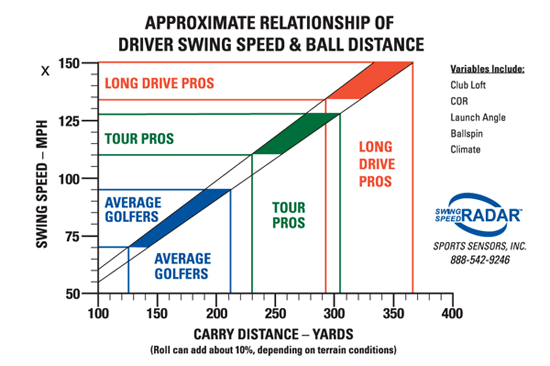 Golf Club Swing Speed Chart
Golf Club Swing Speed ChartWeight:
The weight of the shaft is single greatest contributing factor in determining the total weight of each of the clubs in your bag.
Obviously the Club Head and the Grip do contribute to the club's overall weight, but they simply don't have the same importance as the varying options the shaft offers when impacting that total weight of the club in your hand.
Some golfers do require greater or lesser weight in the Club Head and/or Grip Size, but neither component offers the same degree of options for impacting overall club weight as does the shaft.
Shaft weights generally vary between being as heavy as 130 grams or 4.6 ounces or as light as 40 grams or 1.4 ounces, with steel shafts being on the heavier end and graphite shafts coming in at the lighter end. Therefore, if a golfer were to switch from steel to graphite shafts the average change in their overall club weight would generally fall in the neighborhood of about 50 grams or 1.75 ounces.
Length:
The speed of any object in a circular orbit will increase as that object moves further from its axis point. Think of it this way - if you stand with your arms at your side and turn 180 degrees, your hand will travel at x-miles per hour. But if you now extend your arms out straight and turn your body at the same rate, your extended hand must now travel faster to make the 180 degree rotation in the same time. Make sense??
Now apply that principle to your golf club, The head of a club on the end of a 46" shaft will travel faster that the Club Head on the end of a 42" shaft given a consistent swing speed by the golfer swinging that club.
So now you can see how both Shaft Weight and Shaft Length can impact Club Head Speed and that an optimal balance between the two must exist to maximize the potential for any golfer's unique swing.
The theory goes like this: to take full advantage of the laws of physics a lighter and longer club should be able to be swung faster and thus increase Club Head speed and the resulting force imparted to the golf ball at impact and thus deliver greater distance. The reality however is that simply decreasing weight and increasing length eventually brings into play The Law of Diminishing Returns and then even crosses over into negatively impacting performance.
To achieve that optimal balance between weight and length and maximize performance for any golfer's individual needs the Swing Weight and Length of the entire club must be fit properly to the strength and tempo of the golfer using it. If not, any significant decrease in the total weight or increase in total length of the clubs will simply result in a higher percentage of off-center hits ... and no one wants that!!
Return to Golf Club Design Details
The Golf Club Head
Woods & Hybrids
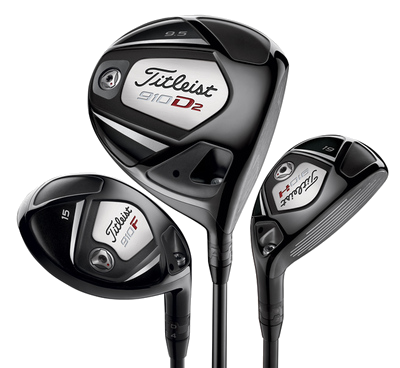 Golf Club - Woods
Golf Club - WoodsStill called Woods today from their origin of having once been typically made from hardwoods like persimmon or hickory, today's Woods are now made mostly from metals like steel and titanium and other alloys. Easily identified by their immense size in relation to the other clubs in the bag, today's drivers range in size up to the legal limit of 460cc.
Large and rounded, the Driver has a flat bottom designed to maximize club face surface area of a club generally designed to be swung above the ground and used to strike a ball off a tee. The Club Face is large and the typical wood has a degree of loft (the angle of the club face in relation to the vertical plane) of about 8 to 14 degrees.
Many of today's Drivers have built-in technology where the Golfer can alter many of the club's features and angles with the simple twist of a screw providing for the ability to alter the club's design after the purchase is made.
Return to Golf Club Design Details
Irons
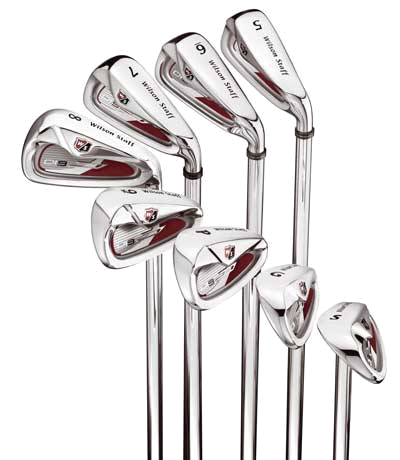 Golf Club - Irons
Golf Club - IronsIrons have club heads typically made of metal and other composites and usually fall into the categories of Forged or Cast.
Forged Irons begin as a solid piece of metal that is then heated and hammered then cooled, repeating the process until the metal is the club the "forger" intended. These clubs are labor intensive, but provide for both a predictable and controllable club preferred by the better skilled players who shape their shots.
Cast Irons are made from metals poured into a cast and can be made in bulk fairly quickly. This process also brought into play the cavity-back iron that provides greater forgiveness in the harder to hit irons and introduced the game improvement category to the Golf Irons Market.
Irons are usually further broken into the categories of Long Irons (1, 2, and 3 irons) - less-lofted clubs used on longer shots over 170 yards, Mid-Irons (4, 5, and 6 irons) - used on mid-range shots of about 140 to 170 yards, and Short-Irons (7, 8, and 9 irons) used in the distances around 125 to 140 yards.
Many golfers today have replaced their long irons with the much more forgiving and easier to hit Hybrid Clubs. Designed with the playability and ease of use of woods and the shot characteristics of an iron, Hybrids have become the go-to club for many amateurs and some pros as well.
Return to Golf Club Design Details
Wedges
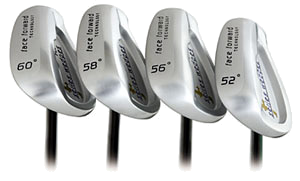 Golf Club - Wedges
Golf Club - WedgesGolf Wedges could be called the most creative clubs in the bag because they are the clubs generally used to get the ball close to the hole on shorter shots near and around the green. Quite often these shots require great imagination and talented creativity to carry over sand bunkers and water hazards to a "short" pin tucked just over the obstacle in front of you.
These are clubs used on tight lies from the fairway, the rough around the greens and out of greenside bunkers. Knowing the loft, lie angle, and bounce of your club and it's primary design function is critical to making the right choice on which wedges to put in your bag and then which one to choose for each shot you'll need to execute.
Return to Golf Club Design Details
Putters
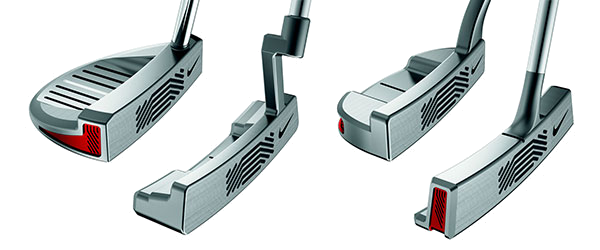 Golf Club - Putters
Golf Club - PuttersThe putter is the most-used club in the bag. Consider that in a typical round of golf the average amateur will hit the ball about 75 to 100 times and anywhere from 25 to 40 of those ball strikes will be made with the putter - that's about 30 to 40% of all the shots you'll hit!
Putters come in as many styles and varieties as any other club in the bag so it's critical that you find one that suits your game and style of play. Consider your stroke and the placement of your hands when you putt. Is your stroke rounded or more in-line? Are your hands low-hanging or more out over the line of your putt? Consider what feels comfortable in your stroke and then practice with putters designed to best perform in concert with your style. Whether toe or heel weighted, bent or straight hosel, blade or mallet design.
Return to Golf Club Design Details
The Golf Club Grip
Golf Club Grips come in many different materials offering a multitude of "feels" and a colorful array of choices that spans the full spectrum of the rainbow.
Manufacturers will proclaim many features designed for optimal performance, but the Golf Grip is the most personal component of the entire club and should be chosen on personal preference alone. Aside from the grip's thick or thinness affecting how the club will behave in your hands, the choice on material is best decided upon by what feels best in your hands.
Return to Golf Club Design Details
Professional Golf Club Fitting
Once reserved for the royalty of Professional Golfers, Custom Club Fitting has come to the masses and is now available to anyone ready and willing to make the investment in their enjoyment of the game of golf.
You'll spend more on the clubs and pay for the service of the Club Fitter, but when you're serious about your game, the investment will prove invaluable.
An Expert Club Fitter will match your personal style and unique swing characteristics with the mountain of technology that goes into today's golf club components and remove all the mystery out choosing the right clubs for your game. Club fitters will work with you to determine the proper: shaft lengths & weights; flex, torque & kick points, spine alignments; and material composition to optimize your equipment. They will also specify correct: grip size; lie angles, face angles, bounce & lofts, and the other important features of each golf club.
The-Golf-Experience.com hopes that this detailed breakdown of what goes into a Professional Golf Club Fitting helps you to better understand the process and what to expect when you're ready to take your game to the next level and get personally fit for your next set of clubs.
Good luck out there and remember to have fun and
"Hit 'em Straight and Not Too Often"
Options for Booking Your Next Tee Time
Go to The Golf Balls Details Page
Go to The Golf Balls History Page
?? Your Own Website ??
Is there a topic or a hobby for which you have a strong passion?
Have you ever considered turning that passion into a passive income stream?
Have you ever considered creating a web site like this one?
I researched long and hard for the best resources available on the web to assist me in making The-Golf-Experience.com a reality and I found none better than Solo Build It with whom to partner.
Above and beyond the comprehensive program they provide to assist you on your journey is the incredible level of customer service you'll get along the way. The world would be a better place if every company out there modeled the quality and level of their customer service after what Solo Build It seems to provide with such ease.
Watch the video below to see if your interest in creating your own web site gets a spark.
You ready?
Now click the "Solo Build It!" link below to begin your own journey.
Good luck and have some fun.
© Copyright The-Golf-Experience.com
"When Health is absent, wisdom cannot reveal itself, art cannot become manifest, strength cannot be exerted, wealth is useless, and reason is powerless."
Herophilos 335-280 B.C.
All athletes require the performance components of: strength, power, endurance, flexibility, coordination, balance, good posture, and mental conditioning to perform at their best.
Stay Healthy - Play your Best
~ ~ ~
Visit our Fitness Page to learn more!
Start investing with Acorns today and they'll add $5 to to your account to help you get started - You won't retire on their contribution ... but $5 is still $5
Visit our page on Golf Balls to learn ALL you need to know to determine which ball is best suited to your unique swing speed and style of play.
Then visit Lost Golf Balls below to buy used golf balls in the quality suited to your game and the quantity required to keep your bag full.
Find Inexpensive Gas with Gas Buddy
If you really want to save at the pump though - Get yourself a Pay With Gas Buddy Card.
Join for free to save $.05 per gallon or get a Plus or Premuim Membership to save $.20 per gallon.
Points are awarded for each score on every hole. You can use any modification for points awarded (or subtracted) on every hole, but the R&A and the USGA award points as follows:
If you appreciate exceptional customer service and personal attention given to filling your golf needs The-Golf-Experience.com highly recommends shopping with









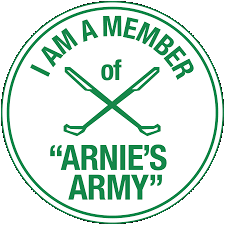



















New! Comments
Join the conversation by sharing your comments and opinions about the content on this topic in the box below.